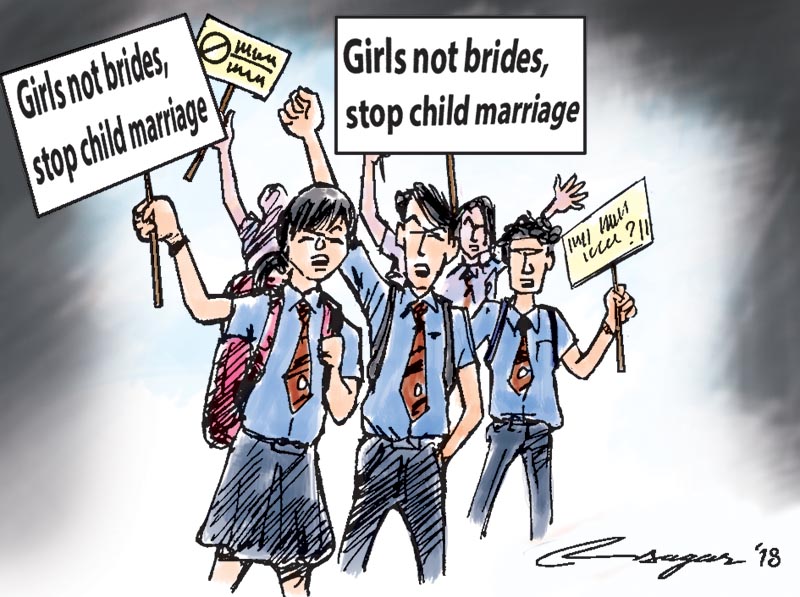End child marriage: Time to act now
We urge the federal, provincial and local government authorities to address the issue of child marriage. Now is the time to address the barriers preventing many young girls from reaching their full potential
“Gaunpalika Mayor commits to ending child marriage”... “Parliamentarians to act tough against child marriage”… “Village girls stop child marriages”… “Priests join the fight against child marriage”.
In recent months we have been seeing an increasing number of such headlines appearing in the media. This, we believe, is a positive sign of how the issue of child marriage is gaining attention in Nepal, thanks to the tireless efforts of many activists.
Nepal has progressive laws against child marriage. The country outlawed the practice long ago – in 1963.
Twenty years is the minimum age for marriage for both men and women [General Code (Muluki Ain) 2020 (1964)]. The 2015 Constitution of Nepal for the first time explicitly prohibits child marriage and affirms that this is a punishable offence. New laws aimed at advancing the cause will be effective from August 2018. The government will have increased responsibility to take action against child marriage. If implemented properly, the laws will provide justice to survivors and serve as a deterrent to would-be violators.
Nonetheless, Nepal has one of the highest rates of child marriages in Asia – for both girls and boys. Nearly two in five Nepali women between 20 and 24 years of age were married before 18 years of age (Nepal Demographic and Health Survey 2016). The prevalence of child marriage in the country varies according to geographic location, education levels, household wealth levels and ethnicity with a significantly higher prevalence in rural areas.
A wide range of factors is placing Nepali girls at risk of child marriage, including gender inequality, harmful social norms, an actual implementation of existing laws and barriers in accessing legal remedies.
The majority of adolescent girls married before 20 years of age have reported the leading causes of child marriage to be parental pressure and “traditional practices” (Adolescent Development and Participation Baseline Study 2014). Parents’ decisions to marry their daughters off at an early age are often driven by conventional views of female sexuality and women’s role in society and pressure from extended families and communities.
They often arrange child marriages with the intention of reducing the financial burden on the family as lower dowry is expected for younger brides.
Nepal has obligations under both international and regional human rights laws to protect the rights of children. For this, Government of Nepal in 2016 endorsed a national strategy to end child marriage by 2030 in line with the Sustainable Development Goals (SDGs). Because the origins of child marriage are multi-dimensional in nature and deep-rooted, working together to end it in synergy is crucial.
Child marriage is not an issue just in Nepal but across the world, spanning continents, religions and cultures.
Worldwide, almost 750 million women and girls alive today were married before their 18th birthday. To eliminate child marriage and to help protect millions of vulnerable girls from losing their childhood, UNFPA and UNICEF are implementing the Global Programme on Ending Child Marriage. The programme, funded by the governments of Canada, the Netherlands, the United Kingdom and the European Union, represents an important collaboration of the development partners to support countries in ending child marriage and ensuring the rights of girls, unmarried and married, are upheld.
Implemented in 12 countries including Nepal where child marriage rates are high, the programme focuses on adolescent girls aged 10 to 19 years at risk of marriage or already in the union.
In Nepal, the programme addresses several key areas including life skills education for girls, policy research and advocacy. Thanks to the programme and support from the key donors, a National Strategy on Ending Child Marriage was developed and endorsed by the Cabinet in 2016 – more than 17,000 girls have received social and financial skills training and 2,000 girls have gone back to school; more than 14,000 parents have also received an orientation on the social and financial skills; and 128 health posts in programme areas are implementing guidelines for adolescent-friendly health services.
The new federal structure in Nepal consisting of three tiers of government provides a unique opportunity to give girls and boys, including those from the marginalised communities, a greater voice in decisions that directly affect their lives. It offers better prospects for tailored policies and programmes that put children and girls’ rights at the centre.
We urge the federal, provincial and local government authorities to address the issue of child marriage as a major obstacle to sustainable development and a fairer future for all children.
With the social and political will to end child marriage stronger than ever, it is clear that change has already started but needs to be accelerated. Now is the time to address the barriers preventing many young girls from reaching their full potential.
Let us work together to end child marriage in our generation.
Baqi is the UNFPA Representative for Nepal and Hozumi is the UNICEF Representative for Nepal






